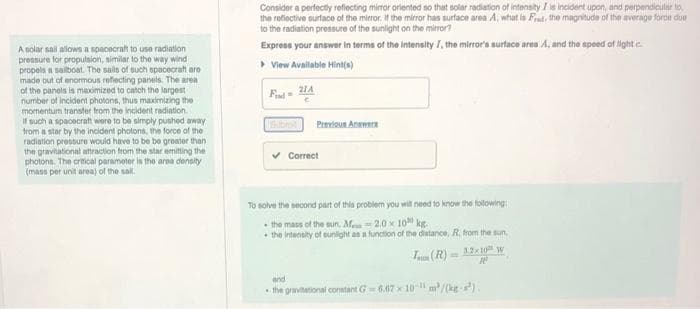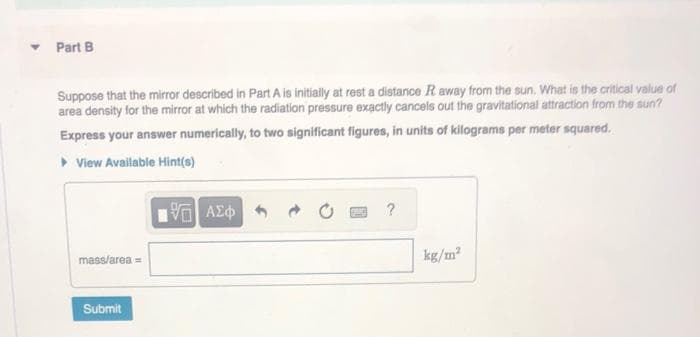▾ Part B Suppose that the mirror described in Part A is initially at rest a distance R away from the sun. What is the critical value of area density for the mirror at which the radiation pressure exactly cancels out the gravitational attraction from the sun? Express your answer numerically, to two significant figures, in units of kilograms per meter squared. ▸ View Available Hint(s) mass/area= 15. ΑΣΦΑ ? kg/m²
▾ Part B Suppose that the mirror described in Part A is initially at rest a distance R away from the sun. What is the critical value of area density for the mirror at which the radiation pressure exactly cancels out the gravitational attraction from the sun? Express your answer numerically, to two significant figures, in units of kilograms per meter squared. ▸ View Available Hint(s) mass/area= 15. ΑΣΦΑ ? kg/m²
Chapter8: Electromagnetism And Em Waves
Section: Chapter Questions
Problem 33Q
Related questions
Question
Please Asap

Transcribed Image Text:A solar sail allows a spacecraft to use radiation
pressure for propulsion, similar to the way wind
propels a sailboat. The sails of such spacecraft aro
made out of enormous reflecting panels. The area
of the panels is maximized to catch the largest
number of incident photons, thus maximizing the
momentum transfer from the incident radiation.
If such a spacecraft were to be simply pushed away
from a star by the incident photons, the force of the
radiation pressure would have to be be greater than
the gravitational attraction from the star emitting the
photons. The critical parameter is the area density
(mass per unit area) of the sail.
Consider a perfectly reflecting mirror oriented so that solar radiation of intensity I is incident upon, and perpendicular to
the reflective surface of the mirror. If the mirror has surface area A, what is Frat, the magnitude of the average force due
to the radiation pressure of the sunlight on the mirror?
Express your answer in terms of the intensity 7, the mirror's surface area A, and the speed of light c
▸ View Available Hint(s)
Find=
21A
Previous Answers
Correct
To solve the second part of this problem you will need to know the following:
the mass of the sun. M
2.0 x 100 kg.
the intensity of sunlight as a function of the distance, R, from the sun,
Tum (R) 12x10 W
10
and
the gravitational constant G=6.67 x 10-11m²/(kg)

Transcribed Image Text:▾ Part B
Suppose that the mirror described in Part A is initially at rest a distance R away from the sun. What is the critical value of
area density for the mirror at which the radiation pressure exactly cancels out the gravitational attraction from the sun?
Express your answer numerically, to two significant figures, in units of kilograms per meter squared.
▸ View Available Hint(s)
mass/area=
Submit
—| ΑΣΦ
?
kg/m²
Expert Solution
This question has been solved!
Explore an expertly crafted, step-by-step solution for a thorough understanding of key concepts.
This is a popular solution!
Trending now
This is a popular solution!
Step by step
Solved in 2 steps with 2 images

Knowledge Booster
Learn more about
Need a deep-dive on the concept behind this application? Look no further. Learn more about this topic, physics and related others by exploring similar questions and additional content below.Recommended textbooks for you


Glencoe Physics: Principles and Problems, Student…
Physics
ISBN:
9780078807213
Author:
Paul W. Zitzewitz
Publisher:
Glencoe/McGraw-Hill

University Physics Volume 3
Physics
ISBN:
9781938168185
Author:
William Moebs, Jeff Sanny
Publisher:
OpenStax


Glencoe Physics: Principles and Problems, Student…
Physics
ISBN:
9780078807213
Author:
Paul W. Zitzewitz
Publisher:
Glencoe/McGraw-Hill

University Physics Volume 3
Physics
ISBN:
9781938168185
Author:
William Moebs, Jeff Sanny
Publisher:
OpenStax

Principles of Physics: A Calculus-Based Text
Physics
ISBN:
9781133104261
Author:
Raymond A. Serway, John W. Jewett
Publisher:
Cengage Learning

Modern Physics
Physics
ISBN:
9781111794378
Author:
Raymond A. Serway, Clement J. Moses, Curt A. Moyer
Publisher:
Cengage Learning

College Physics
Physics
ISBN:
9781938168000
Author:
Paul Peter Urone, Roger Hinrichs
Publisher:
OpenStax College